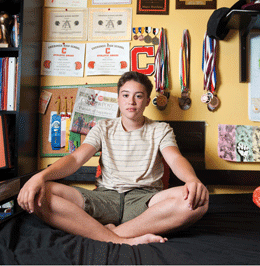
High school years are all about transition, and for one Marlton teenager that meant coming to terms with his true self—as a transgender male.
One thing that 17-year-old Matt Dawkins loves about running—when he’s out on the track, it’s just him.
“I just like the feeling of going really fast. I like running barefoot best, even if it’s on a track. I feel weightless; and I love to go as fast as I can,” he says. “The hectic [atmosphere] of the meets—the gun going off, the stress of having to be at your event on time—it sometimes takes away the joy a little bit. But once I’m on the track and I’m running, it’s just me.”
But it wasn’t always easy for the rising senior at Cherokee High School to find that joy. Matt is a transgender male, currently in the process of transitioning from female to male. And he once resented the very thing that brought him so much happiness.
“When I was running sophomore year, I was kind of running into my depression. The better I would run, the farther I was from transitioning, and so I really resented that,” he says. “I tried to injure myself sometimes. I would not run very well, so I’d be in less races. … I was planning on actually quitting.”
This year, things were different. Matt, who was a star runner on the girls’ team, spent this spring earning his keep on the boys’ squad. For the first time in his high school career, he didn’t have to worry that running track—and being wildly successful at it—was preventing him from becoming who he really was.
According to GLAAD, a media watchdog organization that advocates on behalf of the LGBT community, “transgender is a term used to describe people whose gender identity differs from the sex the doctor marked on their birth certificate.” Gender identity, GLAAD says, is one’s “internal, personal sense of being a man or a woman.” Putting it simply, being transgender means the sex one was assigned at birth does not match their internal gender identity.
And one thing that the organization makes clear: Gender identity and sexual orientation are two different things. “[S]exual orientation is about who you are attracted to and fall in love with; gender identity is about your own sense of yourself,” GLAAD says.
Matt says that’s one thing he wishes people understood about being a transgender person.
“Transgender and sexuality are different things,” he says. “People just, like, tie them to each other and it makes me so angry. … That’s what I’d want them to know—gender and sexuality are two different things. They can be explored whatever way you want to.”
Born Maya, Matt always gravitated toward all things male. “Since I was able to dress myself, I was dressing as a boy. I had short hair in first grade. I had all boys’ clothes—boxers, etc.,” he says. “I didn’t wear a bra until the last second where I had to, so I was very much avoiding all those things.
“My mom told me that when I was little, she knew that I was either going to be a tomboy, gay or transgender,” he continues. “One Christmas, she asked me ‘What do you want for Christmas?’ and I said ‘a penis.’ But then she would ask me all the time, ‘Do you think you’re a boy?’ And I’d say, ‘No, I know I’m a girl.’ But that’s just because I was logical. I knew what body I was in.”
But that didn’t mean that’s what body he wanted to be in.
When high school hit, things got harder. “I’d explain it like the loudest silence you’d ever hear,” Matt says. “When I was in class, I couldn’t focus. My grades started dropping, because I was just thinking about it all the time. … I’d have a bra on, so I was pulling at it. It started to get louder and louder and louder. But it was only in my head, so no one else could hear me screaming. So I would just go to the bathroom, and I’d take all my clothes off and I’d just itch everywhere, because I just felt like…
“No one else knew what was going on.”
Linda A. Hawkins, PhD, LPC, co-director of the Gender and Sexuality Development Clinic at The Children’s Hospital of Philadelphia, says that many transgender kids do realize it early on in life.
“The research on gender development really puts this happening between the ages of 4 and 6 [years old],” says Hawkins. “So as little people are growing up and learning about [gender], … they really start learning about whether or not they fit.”
This is when problems can arise, especially for young children who don’t yet have the language to communicate what they are feeling, she explains.
“That’s when we start to see depression and anxiety in children. There are first- and second-graders having difficulty going to school, difficulty sleeping, unexplained belly aches. It might just be that they don’t really feel connected to their gender but they don’t have the language to articulate, ‘I’m transgender.’”
And while we as a society tend to hear more from kids who are aligned with their assigned sex at birth—that doesn’t mean there aren’t kids on the other side of the spectrum, as well, she says.
“We tend to hear that more from kids who align with their assigned sex,” she says. “In the same way that Janie knows and is confident she’s a girl and that fits in her body and brain and heart and skin and with her family rules, when it doesn’t fit, those kids know it just as well.”
And Hawkins, who began working with Matt last year, has nothing but praise for the way he and his family have tackled a very difficult, and at times confusing, situation.
“Matt is a beautiful representation of identifying his true gender and actualizing it in a really healthy way,” she says.
Matt originally came out as gay, but that felt wrong, too. “I felt kind of like it was off. I didn’t like being called the girlfriend. It just felt weird,” he says.
Then one day while he was perusing YouTube, he found a video called “One Year on T.” Intrigued, he clicked on it, oblivious to the fact that the person on the video was a transgender person, currently in the transition process and on testosterone. Matt watched the video, and the pieces began to fall into place.
“So I started looking at videos, and made a checklist— everything checked off. I felt exactly like these people. I felt like I didn’t have the right body parts. Then I started thinking about it, like ‘I think I’m transgender’. I identify with these people. That’s when I really had self-actualization, where I just knew it.”
Finally, during the winter and spring of his sophomore year two years ago, Matt knew he was ready to take the next step.
“It [became] spring, and I’m really thinking, ‘I have to come out, I have to come out,’ but I wanted to wait until the track season was over,” he remembers. At the time, he was a star on the girls’ team. “I became extremely, extremely depressed because it was really like a lose-lose situation.
“I could transition, but I’d lose my track career. In my mind, I knew that. And then I’d lose all the scholarships. … I was on varsity, I was, like, the best runner, besides the seniors, but I was right with them. But then I would think, ‘If I don’t transition, I can have a great track career, probably go to a really good college, make a lot of money.’ But then I won’t be comfortable with myself, and I’ll have to transition at like, 40, or something.”
Finally, Matt came to a startling realization. “Ultimately, it took me a really, really long time to realize that I am more important—and I don’t want to sound selfish—that I am more important than anyone around me. If I don’t feel comfortable, then I’m not going to be OK being around other people. So I need to do what I need to do before anything else.”
His mother, Tammi Grovatt-Dawkins, a therapist who runs a Haddonfield private practice, remembers that dark time as equally painful.
“His whole sophomore year he was really depressed and crying all the time,” she says. “That was really hard for me to see him like that. And I didn’t really know how I could help him.”
Matt finally gathered up the courage to tell his mom the truth. “I stayed home [from school], and I called her on the phone, and I was like, ‘Mom, I want to go through gender therapy’—I did it softly, like I’m questioning my gender—but really I knew that I was a guy,” he remembers. “So then she kind of went from her mom self to her straight-up therapist self. Very monotone, very professional. She was like, ‘OK, well I will get back to you, I’ll do some research and I’ll see you when I get home.’”
After she digested the news, she sprung into action: setting up therapist appointments, talking to the track coaches, his teachers, the list goes on. But as a mother, it wasn’t easy.
“You’re in completely dark, uncharted territory,” she says. “There’s nobody to refer to. Nobody can really see how this disaster can turn out to be something good. That’s what I was struggling with, like OK, what are we doing here?”
But first and foremost, it was about her child—male or female. “Obviously, his experience of being a person is what matters most,” she says.
Today, it’s obvious his mom is his biggest champion, second only to his twin sister Jada, a cheerleader at Cherokee.
“For me, it was hard at first, and then as soon as he started getting into it, like as soon as we got the ball rolling, it was so easy,” Jada says. “I think that even before, when you said transgender, people thought of drag queens automatically. And no one really heard of a girl turning into a guy, they were like, that’s really weird. But now …on Instagram, you see this whole community.”
Monitoring the situation was also important for Tammi as a mother. “I was just as concerned about how it was affecting [Jada]—they’re not just siblings, they’re twins,” Tammi says. “But when school started and the name change happened, Jada did, to me, the strongest thing. She kind of made this invisible firewall … Like if any of you think you’re going to go after my twin, you’re going to have to come through me.”
Matt took longer to tell his dad, Nigel Dawkins, a trucker who is often gone for long stretches of time.
“I didn’t come out to my dad for a long time,” he says. “My dad and I are not as close as my mom and I. … I didn’t think of telling him until it was necessary or needed. He came to me and was like, ‘What’s going on? Because I know you are not going to tell me.’”
Nigel has since, through his own process of discovery, come to terms with it.
“[At first], he did the traditional, or the predictable thing, which at first he was just like, “I don’t understand why this has to happen now,’” Tammi says. “Losing the scholarship, that was like a big thing … and he doesn’t really understand dysphoria or [that transitioning] is not something where you just kind of go, ‘Gee, I’ll fit that in like another time,’ like learning to SCUBA dive or something.”
Then, Nigel started seeing the news stories on Facebook. He discovered an LGBT station on his long haul trucker radio.
“Then he got on board,” Tammi says.
Sometimes Matt wishes things were easier.
“If I could snap my fingers right now and just be male, I would do it. I want it gone. It would have been so much easier just to have been male from the beginning than to have started right now. I feel like I’m just starting right now. I’m just starting over,” he says. “And I just wanted to know what it would be like to be born male. Would I be the same person? Part of me doesn’t want to change it, because I don’t know if I would have gotten this many connections or experiences, but part of me just kind of wanted to be normal. I just wanted to ... It’s not good to be ‘normal,’ you want to be different. But know biologically how it feels.”
Pronouns are another obstacle, he says. “Pronouns are really, really important because you never realize how much you say pronouns until it actually matters, or you have to correct every person that you run into. Like every day, every person that says, ‘Oh hey, Maya,’ I’d have to say, ‘It’s Matt.’ ‘She.’ ‘It’s he.’ And then they have to question it. It’s so much work,” he says. “I just want them to see me as male, not [think], oh is that a guy or is that a girl? It’s just male.
“I don’t want people to look at me as a transgender athlete,” he continues. “I just want them to look at me as an athlete. I think that’s why I really craved the feeling of being biologically male, because then I wouldn’t have to deal with things like that. I look at myself as just male. And my girlfriend looks at me as just male. We’re not a trans couple. We’re just a couple. It’s not: Jada’s a girl; and I’m a transgender male. She’s a girl, and I’m a male. And we’re twins. It’s that label now.”
But it seems like as far as experiences go, Matt is one of the lucky ones.
According to a recent report by the National Center for Transgender Equality, 90 percent of transgender people polled said they had experienced harassment, mistreatment or discrimination on the job; 22 percent of respondents who had interacted with police reported harassment by police; and 41 percent of respondents said they had attempted suicide. There’s Leelah Alcorn, Riley Matthew Moscatel, Taylor Alesana, Kyler Prescott—all American transgender teens who committed suicide in the last year.
But Hawkins says it’s more complicated than just luck.
“Matt is extremely blessed to be in the family that he’s in. He’s extremely blessed to be so bright and brave and articulate. And he’s chosen to be a remarkable leader in this way. So yeah, I guess he is lucky,” she says. “But I think of luck as being something that someone falls into and this family has worked so hard, I don’t think it’s about luck. It’s about tough conversations, exceptional communication and real growth.”
Matt, too, credits his mom. “I’m so glad that my mom sees the whole big picture, what a relationship is, what love is, [that] this is not going to change anything,” he says.
In many ways, Matt seems like your average teenage boy. He’s talkative, friendly, a bit goofy, and seems comfortable in his own skin. He even has a girlfriend, a fellow Cherokee student.
But for Matt, it wasn’t that simple as finding someone he liked who liked him back. “Before I was going to ask her out, I needed to come out to her, about pronouns, and that I’m going to be transitioning,” he says, “because if we were going to be dating, I’m not going to be referred to as Maya or ‘she.’ I’m going to be referred to as Matt, ‘he.’ I wanted it to be a healthy relationship, no secrets.”
It wasn’t easy.
“I was really dreading it, because I really like this person, I didn’t want to lose her. I didn’t want her to go to her friends and talk about it or whatever; I didn’t know her views on it. At the time, she was also identifying as gay … so I told her and she was so OK with it. I was shaking on the phone. It took me like 20 minutes to actually say anything. … I [said,] ‘I’m transgender.’ And she said, ‘OK, isn’t that when you go from female to male or male to female?’... Alright, well if you want to do that, it’s fine.’”
After being a star on the girls’ track team, Matt this spring became a member of the boys’ team, due in part to the New Jersey State Interscholastic Athletic Association’s transgender policy.
“It took a little bit of research. My mom and my guidance counselor Mrs. [Melanie] Fourney—who is the bomb; she is great—her and my mom did some talking, they figured out that I could run on the guys’ track team in New Jersey, it’s a state law that you are allowed to run with whatever gender that you identify with, as well as the bathroom, you can go to the bathroom as whatever gender you identify as.”
Next was telling the coaches, then the team.
“It just took some talking to the coaches, and telling them what was going to go on, and because I didn’t want to just show up and have to explain everything on the spot. And then I was telling some of the people I knew on the team, ‘I’m going to be running with you,’ and they said, ‘Oh the girls’ team?’ and I said, ‘No, the guys’ team,’” he says.
Fitting in with his new team came in steps. First he observed how they acted, gradually started joking around with them. Then he was added to the group chat online, which he calls the “entryway” into the group. Once he was invited to the Friday night hangout, he knew he was in.
“I was a part of the family. I was brought in,” he says of his new team. “I think it really helped that they knew how I was before, they knew me from before, they knew how committed I was to track and how good I was in my career. [But] it was kind of hard for me, because it was the first time that I wasn’t on varsity, so I kind of felt like the little one. Some freshmen were showing me up sometimes. But I didn’t really think of it—I know my personal best, so I’m just going to do it at that.”
And that first time running in a meet on the boys’ team is something Matt won’t forget.
“That’s one of the first times since freshman year, where I could just run, and feel joy. I was actually being viewed as myself and I could run as just Matt. There weren’t any other problems.”
After meeting regularly with a therapist, undergoing evaluations, meeting with the school guidance counselor and a name change, among others, Matt is now in the transition process. He began testosterone shots—or T—in March. He gets weekly shots of T, usually given to him by Jada. The supplies are in a shoebox in Matt’s room, which has a graffiti-style wall covered in drawings, messages and signatures from friends, family, other journalists who visit. And there are many. So far, the family was on NBC’s Steve Harvey Show, and stories are slated to appear on Vice, ESPN, and a documentary about Matt is in the works.
The vial of T lasts about four months, Matt says, as he draws the clear liquid out of it with one needle, then changes the needle so it’s sharp enough to break the skin cleanly. He disinfects a patch on his thigh with an alcohol wipe, hands the needle to Jada, and says, “Just go in fast, do it fast.”
Jada is nervous because a few weeks ago, she hit an artery in Matt’s thigh, spurting blood. But this injection passes without incident, and both are relaxed, heading back downstairs in the living room to scroll through their cell phones on the couch, heads pressed together, laughing at things they discover on social media.
Matt’s top surgery, a chest reconstruction, is set for early this month.
“Some people do top surgery, but don’t do testosterone, because they are just comfortable with themselves. Or some people do testosterone, but they want to keep their breasts,” he says.
As of now, he’s not sure if bottom surgery, or altering genitals, is for him.
Being a transgender and transitioning from female to male—or male to female, as was the journey of decathlon gold medalist and reality TV star Caitlyn Jenner, who was recently awarded the Arthur Ashe Courage Award at the ESPYs—isn’t black and white. And it’s different for everyone.
“[I]t’s two things. It’s how you feel. I cannot wait for top surgery, because I don’t feel comfortable having this on [gestures to breast binder]. These aren’t part of my body. It’s just like an excess thing. I just want them off. They’re not part of me,” Matt says. “And it’s tied to relationships too. Some people feel like they need bottom surgery to find someone [to be with]. But it’s different for everyone.”
Hawkins agrees, noting there are several factors that contribute to the decisions a transgender person makes while transitioning.
“First, we can look at the macro systems—access to treatment and surgeries and hormones,” she notes. “It’s very much hit or miss when it comes to all people. How close you live to a hospital and what type of insurance you have limits someone’s abilities— or makes the possibilities limitless.
“We all have different thoughts about our bodies, whether you are transgender or just regarding gender ... you have a way of seeing your body, connecting with your body,” she continues. “They have the option of thinking about what could it be like to have my body fit more with my heart and my head?”
And as far as any downfalls of transitioning early in life, Hawkins says the issues are mostly external.
“The primary challenge for anyone transitioning at any time is how other people treat them,” Hawkins says. “People are mean to 7-year-olds and 17-year-olds and … 27 and 77-year-olds. So the pitfall and the downfalls and challenges are not internal. They are really about how the people outside that person treats that person.”
And while Matt’s encountered some negative experiences, they are few and far between. There was one incident at a track meet when students from the other school were pointing and laughing at Matt, noticing his chest binder and his voice, pre-transition. (The T has now changed the pitch of his voice, and spurned the growth of facial hair.)
“It was the first meet we had for the season, and I was getting ready to run my 100, and so I was doing my warm-up routine that I always do, and it was kind of cold and I was taking off my clothes and stuff like that, [as I warmed up], and they saw my binder underneath, and I wasn’t transitioning yet, and I was talking and they could hear my voice,” he remembers. “And some people on the sideline were like, ‘What is that? It needs to go.’”
After his teammates heard about what happened, they were equally incensed. “They said where are they? I’ll go beat them up,” Matt remembers.
“In typical 17-year-old boy adolescent fashion,” his mother laughs. Perhaps it’s a testament to Tammi, who has been a stalwart of support, working to get him the resources he needs. Or perhaps it’s the unwavering support of his twin sister Jada. Or maybe it’s a testament to his community, school administrators, teachers, coaches, even classmates.
While Cherokee High School’s teachers and administrators were not able to speak for this story, Principal Linda Charlesworth did offer the following in an email: “We are very proud of the positive support Matt has been receiving from the students and staff of Cherokee High School, as it is our responsibility is to provide a safe and nurturing environment for every member of the Cherokee family.”
And though a career in track may not be in the cards for Matt, he has other plans. He wants to educate others about being transgender.
“I want to use my experiences in my career. What I want to do with my life is I want to be a public speaker. So I want to do motivational speaking, or parents could come to me that have transgender kids and I could talk or I’d go to different cities and have seminars and talk to people, and they’d have to buy tickets to my show,” he laughs.
Published (and copyrighted) in South Jersey Magazine, Volume 12, Issue 5 (August, 2015).
For more info on South Jersey Magazine, click here.
To subscribe to South Jersey Magazine, click here.
To advertise in South Jersey Magazine, click here.












